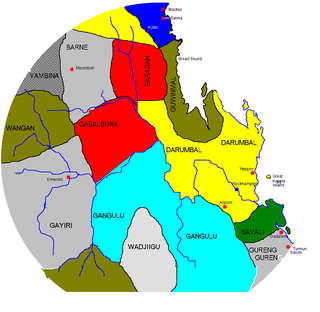
Doomadgee is a town and a locality in the Aboriginal Shire of Doomadgee, Queensland, Australia. It is a mostly Indigenous community, situated about 140 kilometres (87 mi) from the Northern Territory border, and 93 kilometres (58 mi) west of Burketown.

The Aboriginal Shire of Doomadgee is a special local government area in North West Queensland, Queensland, Australia. It is managed under a Deed of Grant in Trust under the Local Government Act 2004.

The Gulf Country is the region of woodland and savanna grassland surrounding the Gulf of Carpentaria in north western Queensland and eastern Northern Territory on the north coast of Australia. The region is also called the Gulf Savannah. It contains large reserves of zinc, lead and silver. The Gulf Country is crossed by the Savannah Way highway.

The Gangulu people, also written Kangulu, Kanolu, Kaangooloo and other variations, are an Aboriginal Australian people from the Mount Morgan area in Queensland, Australia.

The Yukulta language, also spelt Yugulda, Yokula, Yukala, Jugula, and Jakula, and also known as Ganggalidda, is an extinct Tangkic language spoken in Queensland and Northern Territory, Australia. It was spoken by the Yukulta people, whose traditional lands lie on the southern coast of the Gulf of Carpentaria.

Barunggam (Murrumningama) is an extinct Aboriginal language spoken by the Barunggam people of Queensland in Australia. The Barunggam language shared many words with the neighboring languages, including Jarowair to the east, Wakka Wakka to the north and Mandandanji to the west. Kite and Wurm describe Barunggam as a dialect of Wakka Wakka.
Waanyi, also spelt Wanyi, Wanji or Waanji, is an endangered Australian Aboriginal language spoken by the Waanyi people of the lower gulf area of Northern Queensland, Australia. Although earlier thought to be extinct, as of the 2016 Australian census there were 16 speakers of the language. This was down from the recorded peak of 40 in the 2011 Australian census.

The Nicholson River is a river located in the Northern Territory and the state of Queensland, Australia.
The Nguburinji people, also written Ngoborindi, Oborindi and other variations, are an Aboriginal Australian people whose traditional lands lie in northwest Queensland.
The Wangan are an indigenous Australia people of the Isaac Region of Central Queensland. There is no linguistic data.

The Gabulbarra people, also rendered Gabalbura, Gabalbara and Kabalbara, is an Aboriginal Australian people of an area in eastern Central Queensland, but there is little recorded information about them.
The Totj were an indigenous Australian people of far northern Queensland.
The Gia people, also known as Giya, Kia, Bumbarra, and variants, are an Aboriginal Australian people of the state of Queensland. Little is known of them.
The Marrago were an Aboriginal Australian people of the state of the Cape York Peninsula in northern Queensland. They may have been a subgroup of the Mayi-Kutuna.
The Yanga people, also spelt Jangaa, Janggal, Janga, and Yangaa, were an Aboriginal Australian people of the state of Queensland. They may be the same as the Yukulta / Ganggalida / Nyangga group. They are not to be confused with the Yangga.
The Yangga, also spelt Jangga, were an Aboriginal Australian people of the state of Queensland. They are not to be confused with the Yanga people.

The Yambina were an Aboriginal Australian people of the state of Queensland, whose traditional lands lie inland (westwards) some distance from Mackay.
The Yangkaal, also spelt Yanggal, are an Aboriginal Australian people of area of the Gulf of Carpentaria in the state of Queensland.
The Mingin, also known as the Mingginda, are an Aboriginal Australian people of the state of Queensland, who lived in the Gulf Country east of Moonlight Creek and the Yukulta / Ganggalidda people in the southern Gulf of Carpentaria.